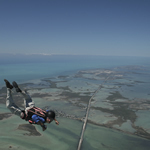Recommended Posts
QuoteI'm re-posting this here to keep from taking off-topic the other thread in which it appeared.
Quote:"There is little or no "droppy feeling" associated with skydiving from an airplane. That feeling comes from acceleration. Going from a slow speed to fast, etc. When you jump from an airplane going 80-90 mph, you're already going that fast when you exit. Speeding up to 120 mph over the next 10 seconds doesn't create much of a "droppy feeling"Is that realy correct?
I think a lot of skydivers say they don't experience the droppy feeling because they have just gotten used to it over time, and it doesn't take very long. But initially, I think novice jumpers DO feel it for the first several jumps.
And I don't think it has anything to do with the horizontal speed of the aircraft or the wind when you exit. It's entirely a function of VERTICAL acceleration only. If you were moving horizontally at 120 mph on a roller coaster and suddenly hit a steep drop, I think you ARE going to feel the droppy feeling, simply because of the vertical drop alone. Likewise, if you jumped from a jet fighter flying horizontally at 600 mph, you would still feel the droppy feeling as you accelerated downward vertically, despite your high horizontal speed.
The droppy feeling comes from negative G-forces, i.e. being lighter than the pull of gravity.
G-forces are defined as x, y and z, where x is the forward direction, -x is backwards, y is to the left, -y is to the right, z is upward, and -z is downward. Or something like that. Positive z forces produce the "heavy" feeling as your weight is increased by more than normal acceleration. Negative z forces produce the "droppy" feeling as your weight is decreased by less than normal acceleration. That's the way I see it.
I think I agree that it IS about acceleration, but disagree that the DIRECTION of acceleration is irrelevant. And there is probably some human physiology involved too...
So, which view is correct?
Here is the correct answer:
When a skydiver leaves the aircraft in horizontal flight he has the full horizontal speed of the aircraft at the instance of exit. The skydiver will then decelerate horizontally while accelerating vertically. Horizontal acceleration/deceleration and vertical acceleration/deceleration are totally independent events and one does not affect the other. For example, if you place a rifle horizontally to the earth (assuming for this discussion that the earth is perfectly flat) and fire the rifle while simultaneously dropping a bullet the same distance that the rifle is above the ground, both bullets will hit the ground at the same exact time. Vertical velocity due to the pull of gravity is always independent of horizontal velocity.
When a skydiver leaves an aircraft with horizontal velocity he decelerates horizontally while accelerating vertically. These forces of acceleration and deceleration cancel one another and your body does not feel the "zero G" sensation. The slower the aircraft exit speed, the more likely you are to feel the vertical acceleration. In a balloon or hovering helicopter with zero horizontal airspeed you will feel the full vertical acceleration.
In summary, the slower the aircraft exit speed the more likely you are to feel the zero G sensation.
Mike Mullins
To add to Mike's description...
Imagine driving a car, a nice, fast car. You start at 0 mph and floor it. You get pressed into the seat until you hit max speed, and then you no longer get pressed into the seat. Even if you go around a corner (changing direction), you don't feel a change in velocity, only a change in direction.
Same with skydiving. Feeling a change in direction from a plane (riding the hill) is not the same as the 'falling' sensation (a change in velocity) that you get from a ballon/heli.
Do or do not, there is no try -Yoda
JohnRich 4
QuoteThe falling feeling comes from acceleration, you don't accelerate significantly when going from plane to freefall.
That depends upon how you're defining "acceleration".
Some people hear, such as you, are using that to mean air speed. And by that usage, jumping from a plane accelerates you from about 80 mph to 120 mph, or "not much". And jumping from a balloon accelerates you from zero airspeed to 120 mph, giving a large difference, and therefore an explanation for the droppy feeling from balloons that is not felt from a plane.
Another definition of acceleration is vertical increase in speed, regardless of starting horizontal air speed. By that measure, acceleration from gravity is identical in both types of jumps: 32 feet per second squared (with overcoming inertia, building air resistance, etc.).
So then we have to explain this phenomenon with the appropriate definition that fits.
QuoteBy your 'arguement' you'd have a sense of falling the first time you jump from a tailgate 'because you don't do it very often', or dropping out the bomb bay doors of a B-17 'because you don't do it very often'.
Negative, because both of those involve airspeeds just like regular skydiving aircraft. What makes balloons and helicopters unique is zero or very low airspeeds. And coincidentally, most skydivers don't jump them very often. Someone who made 20 balloon jumps in a row might feel "droppy" on the first few jumps, but then might get used to the feeling and not notice it any more after the first few zero airspeed jumps. I don't know - does anyone have that many balloon jumps in short succession to vouch for that? How about Base jumpers - the same effect applies there. Do they still get the droppy feeling in their stomach even after dozens or hundreds of Base jumps?
JohnRich 4
Quote
I have a problem with this statement from Wikipedia:
"However, once the body is in free fall (for example, during skydiving), there is no falling sensation. Even though velocity continues to increase, the downward acceleration due to gravity remains constant and does not produce a sensation of falling."It sounds like they think that jumpers continue to accelerate the entire time they're in freefall, which is a common whuffo misunderstanding, and disregards air resistance which gives a terminal velocity. That's they're explanation for for not feeling droppy. However, it's not because acceleration is continuous but at a constant rate, it's simply because acceleration has ceased once you've reached terminal velocity.
I've done a dozen heli jumps in a 2 day period, no change in the 'falling' sense.
Have you ever dropped out of a bomb bay door? There is no wind. You are completely sheltered. There is no way to tell that the plane is moving or if it is standing still... it 'feels' still because you're completely inside. Then you drop out, just like a balloon.
You are inventing definitions of 'acceleration.' By your definition, you would feel acceleration going around the corner in your car due to change of direction, which clearly you do not. I am using a physics definition of acceleration, which is independent of direction.
I'm not sure why you're so hell bent on 'proving' that you just get used to a sense of falling from a plane, when it clearly doesn't exist and both the physics and the biology state otherwise, but hey, if it makes you happy, have at it ![]()
Do or do not, there is no try -Yoda
JohnRich 4
QuoteThe droppy feeling comes from negative G-forces, i.e. being lighter than the pull of gravity.
Skydivers cannot experience negative g from freefall acceleration only. They can only feel a maximum of 0 G.
Further, when skydivers say the felt "negative G" in an aircraft, I doubt it. If they felt negative 1 G then they would have hit the ceiling of the aircraft with their head with their full body weight, likely resulting in injury or death. I employ a technique just before exit where I put the aircraft in a little less than 0 G, say .1 G, which allows tandems and military jumpers with 100 lb rucks to stand up as their body weight is now only about 20 to 30 lbs but this is still positive G, not negative G.
Fair 'nuff. When I was referring to "negative G's being lighter than the pull of gravity", I guess what I meant was less than 1 G, but not necessarily less than 0 G.
That's very polite of you to give those guys with heavy loads a break in the back of the plane. And of course, that's a good technique for floating a raft dive out the door too.
JackC1 0
QuoteHorizontal acceleration/deceleration and vertical acceleration/deceleration are totally independent events and one does not affect the other.
Not quite. Aerodynamic drag doesn't care which direction the wind is coming from, it only cares about the magnitude of it, squared. This mixes up the two components of acceleration so the horizontal component of drag will affect the vertical acceleration due to gravity and this produces a slight amount of lift. Take two identical jumpers, one in a balloon and one in a plane, exiting at the same time. The jumper from the balloon will find themselves at pull time a couple of seconds sooner than the one from the plane due to this effect. It's a well know physical phenomenon.





Share this post
Link to post
Share on other sites